|
|
Post by Drawesome(Dale) on Jan 22, 2008 19:05:38 GMT -5
I like the new Hellsing Anime allot better. It follows the manga much more closely and has better animation. It also goes into the hellsing organization vs the Vatican plot a lot deeper. The head Warrior for the Vatican is much tougher in this series and can actually fight Alucard.
|
|
|
|
Post by Revolver Ocelot on Jan 23, 2008 16:18:19 GMT -5
Claymore
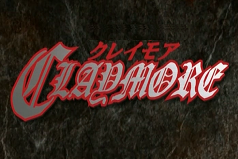
Studio: Madhouse
Director: Hiroyuki Tanaka
Writer: Norihiro Yagi (manga)
Producer: Manabu Tamura, Masao Maruyama & Toshio Nakatani
Composer: Masanori Takumi
Designer: Takahiro Umehara
Released: April 3rd, 2007
Genre: Action, Adventure, Fantasy, Horror
Format: Continuous TV Series
Runtime: 26 episodes, 25 minutes each (650 minutes)
US License: FUNimation 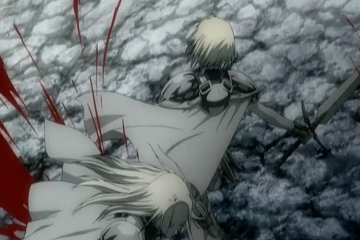 In the dark, medieval fantasy world of Claymore[/i], human beings are hunted by deceptive creatures called “Yoma”, which possess the bodies of humans and use them to infiltrate society. Once they have managed to enter a household, they will kill and consume its tenants before moving on to the next. If discovered, they will shed their human shells and become monsters that no mortal man can stand up against. To combat this constant menace, an organization is created which employs specialized warriors known as “Claymores”; young, beautiful women who have been imbued with the blood of the Yoma. The Claymores are the only ones who are strong enough to defeat the Yoma, and for a hefty fee, they will come to any town that requests assistance and rid it of the accursed creatures.  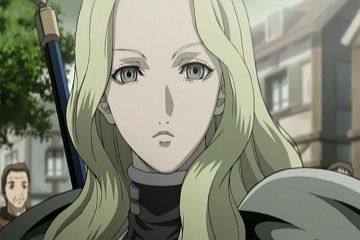 Amongst this organization of female warriors is a young, inexperienced Claymore named Clare. During one of her early missions, she saves a boy named Raki, who immediately falls in love with her and begins following her wherever she goes. Thus, their journey begins. The two get into many misadventures involving Yoma and other Claymores who have fallen from the order. Along the way, Raki learns more and more about Clare’s tormented, tragic past, particularly the story of Clare’s mentor, the legendary Teresa. 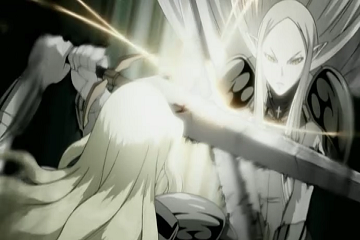 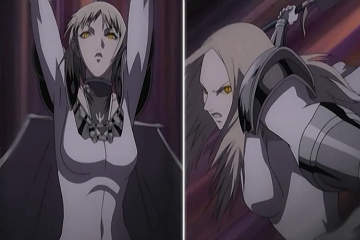 Claymore Claymore[/i] is great low-fantasy at its finest. The bulk of the show consists of Clare traveling from one Yoma battle to the next, but there are some great introspective explorations of the characters, most notably Clare. When we begin, Clare is frigid and emotionless. But through her interactions with Raki and her encounters with other Claymores and Yoma, specifically the transcendent Yoma known as “Awakened Beings” and her increasing knowledge of the relationship between all of these elements, Clare begins to change rather dynamically. 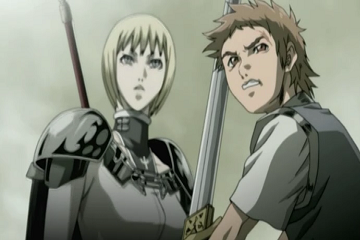 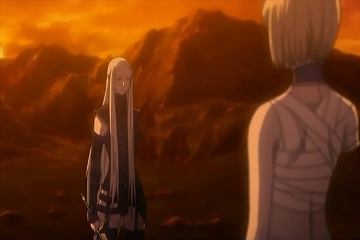 One of the things I enjoyed most about Claymore[/i]’s story is how it utilized women. Unlike most anime (and most forms of entertainment in general), the women in Claymore[/i] are not presented in a sexual manner. While attractive, they maintain an almost sexless air about them, and at least on the surface, they seem not to be preoccupied with romance or the pleasures of the flesh. No skimpy outfits, no watermelon tits, no naked bathing scenes. The Claymores are just badasses who kill things, and do so without constantly reminding you that they are women. In stark contrast, the men in Claymore[/i] are all virtually helpless. I feel that this is a nice and much needed role reversal for anime. 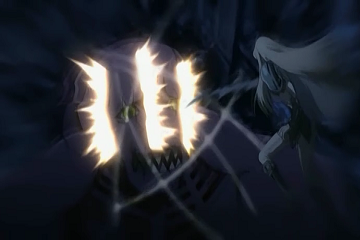 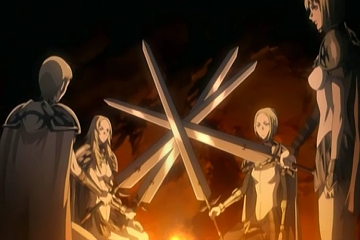 However, as nice as the story is, Claymore[/i] is foremost an action show. The fight scenes are the core of the show, and if you are not a big fan of action, gore and the staple “technique-talk” of shonen anime, there is a good chance that Claymore[/i] will not tickle your fancy. But if you do appreciate amazing fight scenes when you see them, Claymore[/i] will be absolute bliss. You will be hard pressed to find a show more violent and brutal. Even Berserk[/i] does not compare. Hell, even Hokuto no Ken[/i] does not quite elicit the same cringes that Claymore[/i] gave me. As much as I am a fan of character development and great narrative, I would be lying if I said the fight scenes in Claymore[/i] did not fill me with boyish glee. 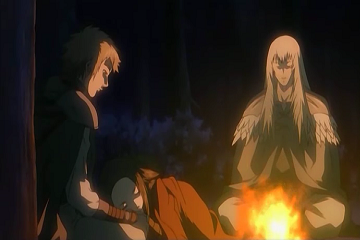  On the technical side of things, Claymore[/i] is equally impressive. As a Madhouse production, you are pretty much guaranteed top notch animation. The show remains consistently smooth throughout its run, with perhaps a bit of emphasis placed on the fight scenes. What really sells the presentation, however, is the art style. The shading, lighting, and use of color work well in making Claymore[/i] as fittingly dark and dreary as possible. Being based on a beautiful graphic novel-quality manga, Claymore[/i] had big shoes to fill in terms of its visuals, and it completely achieves success here by capturing the look of the manga perfectly. 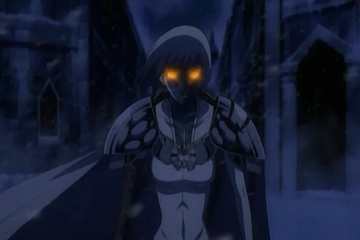 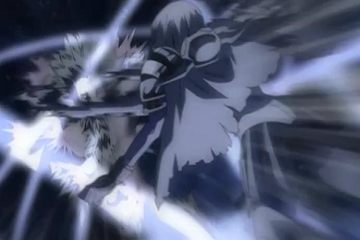 Another thing that carries Claymore[/i] along is its great music, a mix of haunting instrumental pieces and visceral metal. Some of the themes here are very memorable, particularly the incredible ending song, Danzai no Hana ~Guilty Sky~, a symphonic rock hybrid with beautiful lyrics. 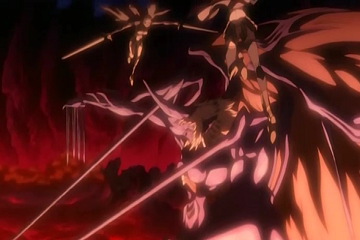 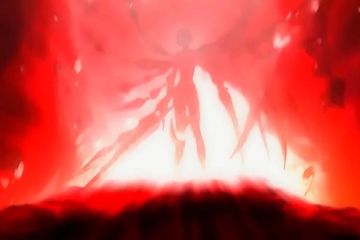 Claymore Claymore[/i] is a great show, but it is not for everyone. If you are into more poignant stuff and are not enamored by fight scenes, you may want to pass up Claymore[/i] and watch Berserk[/i] instead. But if you love action and brutality, Claymore[/i] just might be your ticket to a great time. In all, it is one of the best all-out action/fantasy shows I have seen in a long time. - Shalashashka
Story: B
Animation: S
Design: S
Music: S
Direction: A
Overall: AOP: “Raison D'etra” by NightmareVery sensational rock song. Starts out good, but the lyrics are kind of whiny. ED: “Danzai no Hana ~Guilty Sky~” by Riyu KosakaAs mentioned in the review, this song is a beautiful symphonic-rock hybrid with great vocals.
|
|
|
|
Post by Atma on Jan 23, 2008 19:40:26 GMT -5
FUCK YES CLAYMORE I LOVE YOU SO MUCH RIGHT NOW
It's my favorite manga currently and the show does it so much justice. For a Shonen Jump adaptation, it kicks major levels of ass. Clare is my hero. Rock on.
|
|
|
|
Post by Revolver Ocelot on Jan 23, 2008 20:03:47 GMT -5
FUCK YES CLAYMORE I LOVE YOU SO MUCH RIGHT NOW Oh really? How much?  Rawr. Anywho.. as much as I love Clare, I'm all about Teresa.. |
|
|
|
Post by Kyrael Seraphine on Jan 24, 2008 0:51:35 GMT -5
For a Shonen Jump adaptation, it kicks major levels of ass. <- READ THIS WAY <- READ THIS WAY <- READ THIS WAY <- READ THIS WAY <- READ THIS WAY ... |
|
|
|
Post by Revolver Ocelot on Jan 26, 2008 17:33:24 GMT -5
Mobile Suit Gundam MS igLoo: The Hidden One-Year War
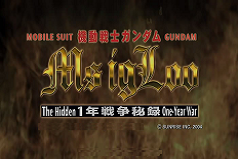
Studio: Sunrise
Director: Takashi Imanishi
Writer: Asahide Ookuma & Hiroshi Ohnogi
Producer: Koichi Inoue, Satoshi Kubo & Takashi Imanishi
Composer: Megumi Oohashi
Designer: Shinji Aramaki (characters), Hajime Katoki, Kenki Fujioka, Kimitoshi Yamane & Yutaka Izubuchi (mecha)
Released: July 19th, 2004
Genre: Drama, Mecha, Sci-Fi
Format: OVA
Runtime: 3 episodes, 25 minutes each (75 minutes)
US License: Bandai (Honneamise)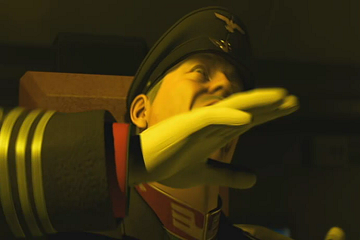 Hm. One only makes this expression when watching this OVA. Quite the paradox. Hm. One only makes this expression when watching this OVA. Quite the paradox.The Gundam[/i] metaverse is quite possibly the largest of its kind to come out of Japan. To someone who is not a fan of the Gundam[/i] franchise, looking in on it from outside is mind-boggling. There is so much crap all over the place, multiple universes, multiple timelines, sagas released out of order. Where does one even begin? Well, if you want to be chronological standpoint, MS igLoo[/i] is technically where you should start. 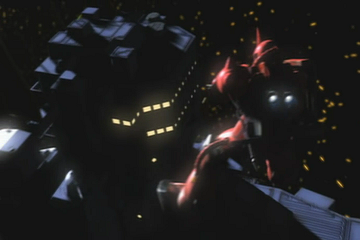 Char: "I've found the studio where they made this god awful OVA. May god have mercy on their souls.." Char: "I've found the studio where they made this god awful OVA. May god have mercy on their souls.."Beginning just prior to and eventually taking place simultaneously with the original Mobile Suit Gundam[/i] TV series set in the future year UC 0079, MS igLoo[/i] is a major departure for the Gundam[/i] franchise. For one, this is the first new series of any kind based on the Universal Century (the original Gundam timeline, for those of you not familiar with the saga) to be released since 08th MS Team[/i] in 1996. Since then, Sunrise has brought one new “universe” after another to the US, most notably Gundam Wing[/i], which was a major hit in the US thanks to Cartoon Network. Secondly, this is the first series in the entire Gundam[/i] franchise to use 3D animation exclusively. But does this signify a wondrous and revolutionary leap for this aging metaverse? In short, HELL NO. This OVA SUCKS ASS. Sweet Jesus in heaven, what in the everloving fuck were they thinking? Alright, so that was pretty visceral. But man, this pathetic OVA deserves it. 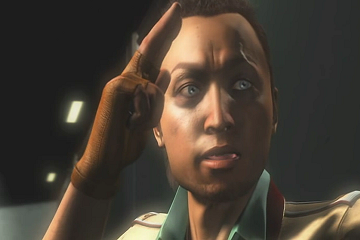 Derek Jeter says, "Two in the pink..." Derek Jeter says, "Two in the pink..."The tragic thing is, MS igLoo[/i] has a great concept. Rather than focus on the Earth Federation like just about every other UC-based show out there, MS igLoo[/i] takes the perspective of the Principality of Zeon. This is the story of the Jotunheim and her crew, the 603rd Mobile Suit Technical Division. The 603rd division is a team of soldiers who test experimental mobile suits that the Zeon are desperately trying to push to production during these final days of the One-Year War. Amongst the 603rd division is a young man named Oliver May, and it is through his journal entries that the story of MS igLoo[/i] is told. 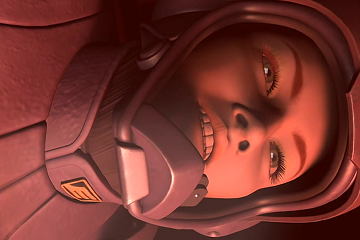 "ARGH!! Can't.... hold it.... anymore..." "ARGH!! Can't.... hold it.... anymore..."In spite of this fascinating concept which had mounds of potential, MS igLoo[/i] completely falls flat thanks to a combination of bad writing, formulaic plot and horrible characters. All three episodes of this short OVA are exactly the same. The 603rd division is asked to try a new experimental mobile suit or mobile armor, a new attitude-filled character is introduced to test it, during the test, combat breaks out, something goes wrong, and the test pilot dies. Everyone on board the Jotunheim cries and sobs and the audience is expected to feel bad for this new cliché character we just got introduced to 15-20 minutes ago. By the third episode, you already know who is going to die, when they will die and how they will die. I have never had my intelligence insulted with such predictability in my life. The plot consists of one bullshit sob story after another, and it attains a level of sappiness even the King of Sap himself, Yoshiyuki Tomino, never even came close to. 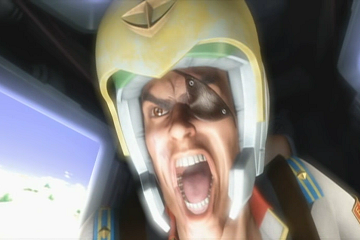 Having ripped out his own eye in a rage, Jay Leno continues to voice his frustrations in regard to the writer's strike. Having ripped out his own eye in a rage, Jay Leno continues to voice his frustrations in regard to the writer's strike.Now with that out of the way, I can talk about the show’s most talked-about aspect, its animation. Yeah, this show is pretty ugly. Not that I was expecting Final Fantasy: The Spirits Within or anything, but surely, Sunrise could have done better. The characters do not look all that bad so long as their mouths are not moving. But when they get into the mobile suits, things really get ugly. The majority of video games that have come out with the past 7 or 8 years have had better CG than the mobile suit battles in MS igLoo[/i]. Hell, many video games have in-game graphics more appealing than this OVA. It is not that they are simply ugly. It goes way beyond that. They move completely wrong. Most of the time, the humanoid suits move just like people do, which is somewhat creepy. Both them and the battleships and mobile armors that populate this OVA universally move too fast and have absolutely no concept of physics. It all just looks so fake. 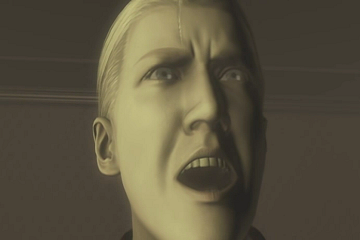 Oliver: "What?! They actually published this shit?!" Oliver: "What?! They actually published this shit?!"Another problem with the visuals in this OVA, which is a common problem with many of the newer re-explorations of the UC saga, is that the technology in this show is way too advanced. Just like the giant mobile armor that had a laser canon which could destroy a city in 08th MS Team[/i], or the Neue Ziel from Stardust Memory[/i] that could toss battleships around like toys, one begins to wonder just where the hell these monstrosities were when Zeon was fumbling around with Zakus and the ridiculous Ziong in the original Gundam[/i] show. Call me nitpicky if you want, but the technology just does not match up well, particularly the bad-ass tank in the second episode when compared to the ridiculous looking paper tanks Amuro tore through in tandem during Mobile Suit Gundam[/i]. 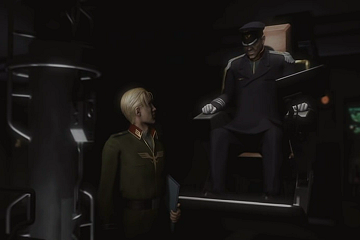 Oliver: "Hmmm.. looks like the captain fell asleep. Must've been watching MS igLoo..." Oliver: "Hmmm.. looks like the captain fell asleep. Must've been watching MS igLoo..."Even the music is not very good. The intro and ending themes are nice, but throughout the action, the music is very forgettable and sounds mostly synthesized and cheaply composed. The only pieces that really stand out are the remixes of some of the battle themes from the original Mobile Suit Gundam[/i], which will provide you with a bit of nostalgia but not much else. While I am talking about the music, I might as well mention the voice acting. It is adequate, but does not synch up with the lip movements of the CG characters at all. This stems from Japan’s process of typically animating the feature before casting the voice actors or doing the recordings, the opposite of the American system in, say, Disney, where the characters are animated to match the performances of the actors. It is not as evident in 2D animation, but it really rears its ugly head here. 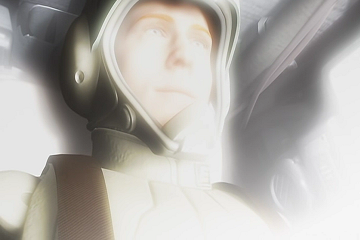 "So what if I'm dying? At least I'll be out of this horrible OVA. Take me now, God.. take me now.." "So what if I'm dying? At least I'll be out of this horrible OVA. Take me now, God.. take me now.."All in all, I have to say this is probably the worst entry to the Gundam[/i] universe I have ever experienced. Unless you are a TRULY hardcore Gundam[/i] fanatic who obsesses over the technical specifics of the mobile suits and beats off to pictures of model kits, this OVA will have absolutely no merit to you. I strongly advise that you pass this one up and not make it popular, otherwise Sunrise might make more of these. Oh wait… too late. Keep a look out for my review of the sequel to this awful mess, MS igLoo: Apocalypse 0079[/i]. Whooboy… - Shalashashka
Story: F
Animation: D
Design: D
Music: C
Direction: F
Overall: F
Sub or Dub: Neither. Stay away from it in any language.
OP: “The Origin of Space-Time” by TajaNice, somber, slow intro song. Fits the sappy tone of the show. BInterested in this anime? Buy it here!
|
|
0405
New Member

Posts: 11
|
Post by 0405 on Jan 28, 2008 15:41:23 GMT -5
Gunparade March
In order to form these military teams, a draft is made. And of course, like so many other mecha shows, the candidates for the pilots are exclusively pubescents. I have always wondered why the leaders of military organizations in anime shows always seem to think that the best way to save the world is to give a team of insecure, hormonal, angst-ridden and impulsive teens extremely dangerous and expensive robots, but I guess that sort of thinking is the reason I am not an anime director. It's been a while since I've seen GPM, but I'm pretty sure the choice to have teens pilot the robots wasn't made arbitrarily. From what I remember, the war had been raging since the end of WW2, and humanity had been losing badly the entire time. I remember them showing a world map or something like that at the opening of the series, and it's revealed that parts of Japan and a few other countries are the only ones that haven't been decimated and taken over by the Genju. The army was basically running out of soldiers, so they started a student draft giving the students two options: They could serve for four years, then do whatever they wanted, or be placed into a profession that had been pre-selected for them for 30 years. |
|
|
|
Post by Revolver Ocelot on Jan 28, 2008 20:13:04 GMT -5
It's been a while since I've seen GPM, but I'm pretty sure the choice to have teens pilot the robots wasn't made arbitrarily. From what I remember, the war had been raging since the end of WW2, and humanity had been losing badly the entire time. I remember them showing a world map or something like that at the opening of the series, and it's revealed that parts of Japan and a few other countries are the only ones that haven't been decimated and taken over by the Genju. The army was basically running out of soldiers, so they started a student draft giving the students two options: They could serve for four years, then do whatever they wanted, or be placed into a profession that had been pre-selected for them for 30 years. Do you think the shortage of adult soldiers is the reason why they drafted teen soldiers, or do you think the director/writer's want for teen characters is the reason why they wrote in that shortage of adult soldiers? I'm thinking the whole backstory behind the war is just a catalyst to make a show about a bunch of young kids. |
|
0405
New Member

Posts: 11
|
Post by 0405 on Jan 29, 2008 11:19:15 GMT -5
Do you think the shortage of adult soldiers is the reason why they drafted teen soldiers, or do you think the director/writer's want for teen characters is the reason why they wrote in that shortage of adult soldiers? I'm thinking the whole backstory behind the war is just a catalyst to make a show about a bunch of young kids. I don't think the director/writer's intentions matter all that much, to be honest. Your comments made it seem as though, story-wise, the government decided to have teens be soldiers just 'cause, and I was just pointing out that, story-wise, the decision wasn't made arbitrarily. |
|
|
|
Post by YourAverageJoe on Jan 29, 2008 13:23:07 GMT -5
Yeah, but when was the last time you saw a mecha show where the main character was a rugged guy in his 40's, brimming with experience and manliness?
|
|
0405
New Member

Posts: 11
|
Post by 0405 on Jan 29, 2008 13:47:11 GMT -5
Yeah, but when was the last time you saw a mecha show where the main character was a rugged guy in his 40's, brimming with experience and manliness? A couple months ago, when I watched GunXSword(although, I don't think Vaan was 40). I'm not quite sure what that has to do with my post, though. |
|
|
|
Post by Revolver Ocelot on Jan 29, 2008 14:50:35 GMT -5
Megazone 23 Part II
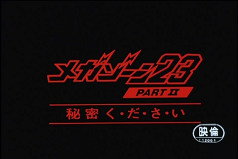
Studio: AIC
Director: Ichiro Itano
Writer: Hiroyuki Hoshiyama
Producer: Toru Miura
Composer: Shiro Sagisu & Hiroaki Serizawa
Design: Yasuomi Umetsu (characters) & Ichiro Itano (mecha)
Released: May 30th, 1986
Genre: Action, Cyberpunk, Mecha, Thriller
Format: OVA Movie
Runtime: 85 minutes
US License: ADV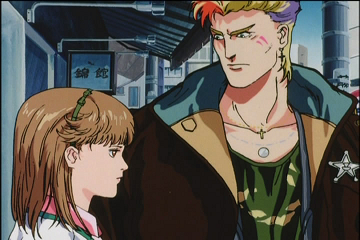 It took well over a year, but finally, in 1986, Megazone 23[/i] got the continuation to its story. But it was not quite what any of us who enjoyed the first OVA were expecting. The first OVA virtually ended with a cliffhanger, and that cliffhanger is not continued here. 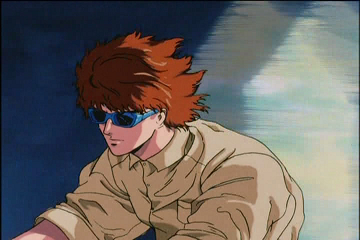 Quite some time has passed since the first OVA, and things are very different. BD, the antagonist, is still exploring the inner secrets of Megazone 23 and is attempting to breach EVE’s final levels of protection in order to have complete control. Meanwhile, Shogo Yahagi, who barely escaped from BD alive in the first movie, has gone back underground with his gang of biker buddies, yet he is still haunted by EVE calling out for him. Yui has also gone back to business as usual, and has not seen Shogo since the incidents in the first OVA. 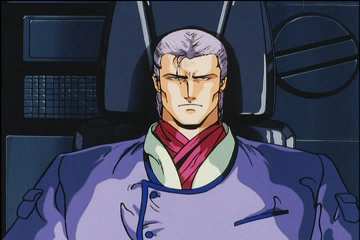 Megazone 23 Part II Megazone 23 Part II[/i] is a major departure from the first OVA in nearly every respect, and in many ways, it is quite a disappointment. The most major and damaging change is the pace. We left Shogo last time with him having just discovered the truth behind the fake world the people of the city live in. Things were really picking up, and the conflict between Shogo and Bahamut had come to a head. Now, we are reunited with Shogo, who is doing nothing more than running amuck with his adolescent biker friends. The atmosphere too has changed. The story is much grittier and more angsty this time around. 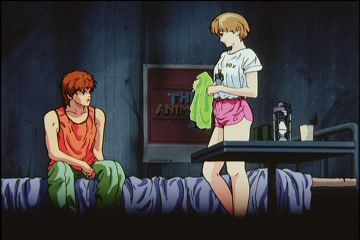 Of course, Megazone 23 Part II[/i] does not waste all of its 85 minutes on the bike gang’s shenanigans. Toward the end of the OVA, we finally get back into the story we were engaged with in the first OVA. The plotline with EVE and the Megazone itself finally comes full circle, and we even get some closure on the conflict between Shogo and BD. The problem is that as fascinating and satisfying as all this stuff is, it comes in about 15 minutes before the end credits roll. All that time wasted with the bike gang and more of Shogo and Yui’s endless humping would have much better been spent fleshing out the conclusion of this wonderful story. It is frustrating, to say the least. 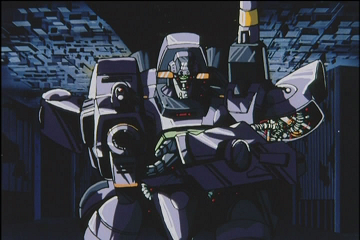 Possibly more drastic than the change of pace is the complete transformation that the OVA has undergone visually. It will be very difficult for those who watched the first OVA to reacquaint themselves with these characters. Shogo now has red hair and looks like he is in his mid 20s. Yui is blonde. BD has grey hair now and has put on about 100lbs of muscle. The art style has completely changed, aiming for a much more realistic look, to the point where it does not even look much like an anime anymore. That is not to say Megazone 23 Part II[/i] looks bad. Quite the contrary. The animation is still amazing and still completely overpowers anything you would have seen on TV at the time. The level of detail is incredible, and the graphic gorefest scenes are fun to watch. 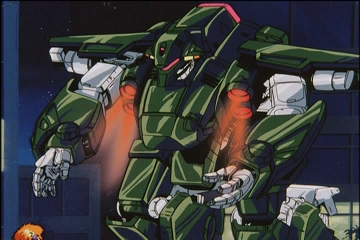 One thing that has not changed is the music. If you enjoyed the 80s pop feel of the first OVA, you will definitely not be disappointed with Megazone 23 Part II[/i]’s soundtrack. EVE continues to sing her wonderful songs throughout the feature, with the ending piece being the most striking. The background music is still based heavily in hard, synthesized rock. 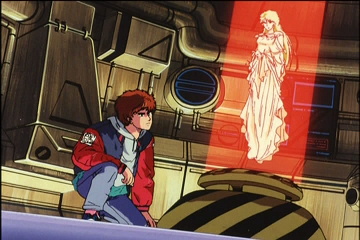 Fortunately, reacquainting yourself with the drastically redesigned characters will not be too hard thanks to the original voice actors being retained on both the Japanese and English fronts. ADV does yet another bangup job with this OVA, though their delightful and intended cheesiness from the first OVA is gone here, and the actors take a more serious tone to coincide with the darker tone of the feature. Once again, Allison Keith is wonderful as Yui, and Vic Mignogna does some good work with Shogo, though his young-sounding voice does not quite adapt to Shogo’s new appearance very well.  All said, Megazone 23 Part II[/i] is a disappointment. It is mostly enjoyable, but there are some very boring and completely unnecessary parts to it that fudge up the pacing pretty bad. The story does not mesh with the first OVA well, and the redesigned characters are very awkward. At the very least, however, Megazone 23 Part II[/i] provides an excellent conclusion to the story with its poignant ending, which I suppose is better than if the OVA would have started out great and ended badly. Either way, I cannot help but think they could have done better. - Shalashashka
Story: C
Animation: A
Design: C
Music: A
Direction: D
Overall: C
Sub or Dub: Either, but preferably dub.Interested in this anime? Buy it here!
|
|
|
|
Post by Protodude on Jan 30, 2008 16:38:12 GMT -5
I thought there was a Megazone Part III?
|
|
|
|
Post by Revolver Ocelot on Jan 31, 2008 16:52:06 GMT -5
Neo Ranga

Studio: Studio Pierrot
Director: Jun Kamiya
Writer: Sho Aikawa
Producer: Pony Canyon
Composer: Kuniaki Haishima
Designer: Hiroto Tanaka (characters) & Shiho Takeuchi (mecha)
Released: April 6th, 1998
Genre: Comedy, Drama, Kaiju, Mecha, Slice-of-Life
Format: Arcing TV Series
Runtime: 48 episodes, 13 minutes each (625 minutes)
US License: ADV 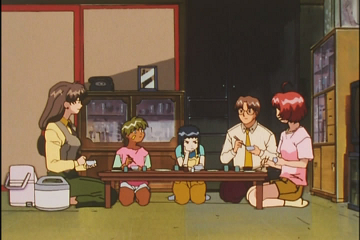 Neo Ranga Neo Ranga[/i] is a very difficult anime to classify. It starts off as one thing and goes through several transformations. At first glance, it is something of a classic kaiju show, then sort of a mecha show. But underneath it all, Neo Ranga[/i] is truly a satire of Japanese society. 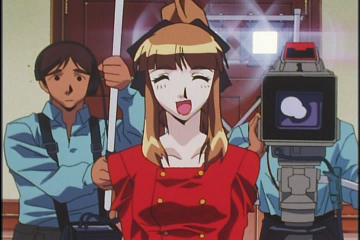 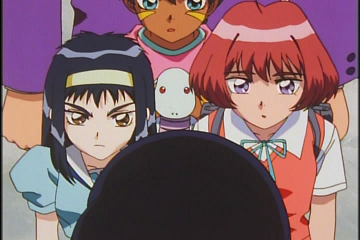 Neo Ranga Neo Ranga[/i] is primarily the story of the three Shimabara sisters, who live alone after the deaths of their parents and the mysterious disappearance of their older brother. The eldest sister, Manami (24), acts as a mother to her two younger sisters. Ushio (15) is a very outspoken and righteous girl. The youngest sister, Yuuhi (13), is very selfish and uses her good looks to manipulate those around her. Their lives are changed one day when a giant monster called Neo Ranga (along with a strange young messenger named Joel) comes ashore, wreaks havoc across Japan, and ends up at the home of the Shimabara sisters. 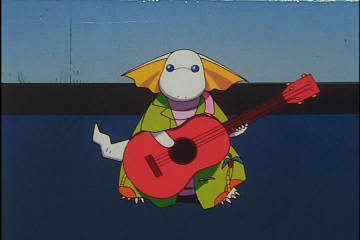 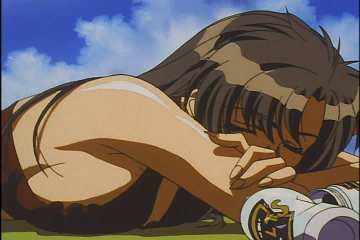 The sisters (primarily Ushio) discover that they have some sort of unexplained control over Ranga. Through Joel and other strange visitors whom the Shimabara sisters encounter, they begin to discover more about their relationship with Ranga and Ranga’s relationship with their missing brother. Along the way, they meet many colorful characters with whom they share their neighborhood, they must deal with the constant social backlash in response to Ranga’s presence, and ultimately, they have to use Ranga to wage battles against the Kyoshinkai, a group of religious fanatics seeking to destroy the mysterious monster. 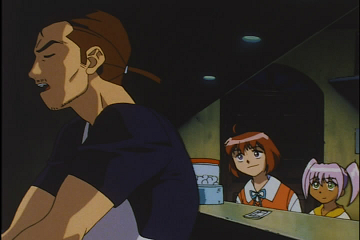  While Neo Ranga[/i] has a very interesting premise laden with potential, it just does not work out at all. This is due to the combination of several factors. First and foremost, Neo Ranga[/i]’s length. Each episode is only half as long as the usual anime episode; about the length of your average William’s Street production like Aqua Teen Hunger Force or Harvey Birdman. While the show is a hefty 48 episodes long, it still tries pretty hard to tell a complete story in each episode. There are several story arcs where episodes lead right into one another, but for the most part, you are getting a half-hour’s worth of exposition in 15 minutes. This makes some of the episodes very jumpy and muddled, and makes more than a few elements of Neo Ranga[/i] pretty confusing. 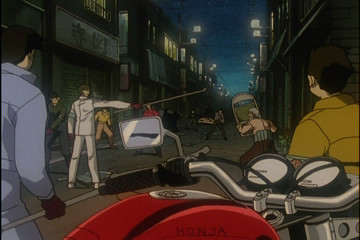 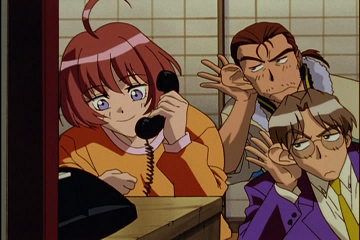 The second problem is that Neo Ranga[/i] cannot quite nail down a genre. Sometimes it wants to be a drama, sometimes it wants to be a slice-of-life comedy, other times it wants to be a monster-of-the-week kaiju show. While this style offers a lot of variety, it does not offer much consistency. After awhile, I began to get annoyed that what appeared to be an interesting, budding story arc was abandoned so the show could go off in a whole new and often random direction. I guess this is what academic counselors have to deal with when they have a college student who changes majors every semester. 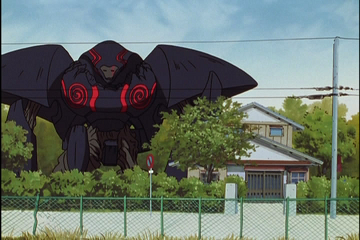 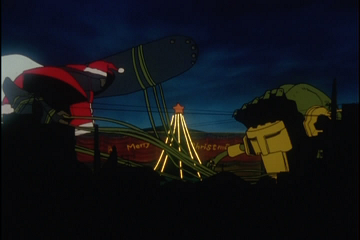 Only toward the ass end of the series does any real continuity take place, and while those episodes are pretty interesting, it is too little, too late. The damage has been done, and several seasons’ worth of episodes have been wasted with aimless meandering. It is a shame too, because the show has such a good setup and gives off some great, atmospheric vibes that are never quite fully realized. Those awesome looking weapons you see the sisters wielding on the box art? Yeah.. those never appear. I cannot help but think the initial plan for Neo Ranga[/i] was a bit different than how things turned out, and I would have liked to have seen the better moments of the show fleshed out into a more viable and satisfying story. 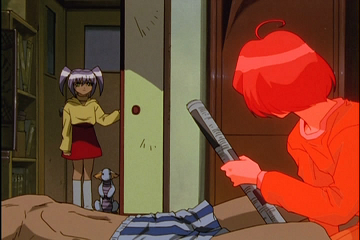 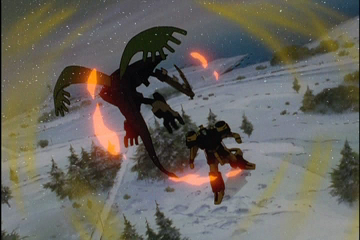 On the plus side, Neo Ranga[/i] at least looks pretty damn good. While the animation is not spectacular, it is definitely a cut above the rest when graded with late 90s standards in mind. Where it really shines, though, is in its artwork and design. The characters all have a very distinct look and the art style has an effective, detailed, hand-drawn grittiness to it that you do not see a lot of anymore. The only problem is that there is a fairly noticeable, abrupt change in art style toward the end of the series. The music is also good and carries the series along fairly well, though I cannot say I remember much of it. To round out the sound category, the show has an excellent dub by ADV, and some of the English voices seem to fit the characters even more than the Japanese ones. 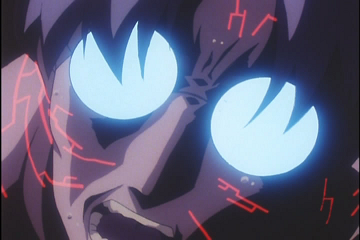 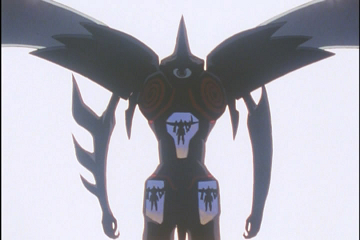 So while Neo Ranga[/i] has some great ideas and excellent production values, it fudges its execution. Certainly, there are plenty of great moments here and whole episodes that are entirely enjoyable. The problem is that you have to trudge through countless episodes that feel squished and ultimately pointless to find them. Still, Neo Ranga[/i] is strange and original enough to warrant watching. If you can put up with its randomness and incompleteness, you may find a rather rewarding experience. - Shalashashka
Story: D
Animation: A
Design: A
Music: B
Direction: D
Overall: C+
Sub or Dub: Either, but the dub is slightly more fitting.
OP1 (1-24): “Kaze no Nemuru Shima” by Miyamura Yuko, Sumitomo Yuko & Sendai EriA very fitting, Nazca-themed intro song with no traces of J-pop. B
ED1 (1-24): “Prologue ~ A City in the Sky” by Ito MasaakiA jazzy ending song with Japanese mixed with Engrish lyrics. Sounds like something out of Marvel vs. Capcom 2. C
OP2 (25-48): “Kami no Nare” by Kuniaki HaishimaSame style as the first song, but much more chaotic to reflect the deteriorating situations in the show. B+
ED2 (25-48): “Kawaki no Miwa Ni Te” by Miyamura Yuko, Sumitomo Yuko & Sendai EriThe only J-pop song in the soundtrack, and it is surprisingly awesome. AInterested in this anime? Buy it here!
|
|
|
|
Post by Revolver Ocelot on Feb 1, 2008 8:47:06 GMT -5
Fullmetal Alchemist

Studio: Bones
Director: Seiji Mizushima
Writer: Akatsuki Yamatoya, Aya Yoshinaga, Jun Ishikawa, Katsuhiko Takayama, Natsuko Takahashi, Shou Aikawa & Toshiki Inoue
Producer: Hiro Maruyama, Masahiko Minami & Ryo Oyama
Composer: Michiru Oshima
Design: Yoshiyuki Ito
Released: October 4th, 2003
Genre: Adventure, Fantasy
Format: Continuing TV series
Runtime: 51 episodes, 25 minutes each (1275 minutes)
US License: FUNimation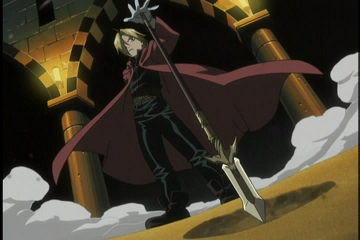 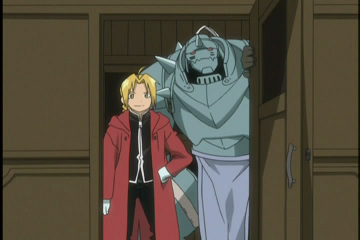 If one were to look at a timeline of anime history, major events would be marked with certain key titles. You would note how shows like Astro Boy[/i] and Tetsujin #28 got the ball rolling, and how certain landmarks like Mazinger Z and Mach GoGoGo got us through the 60s. You would explain how Space Battleship Yamato and Mobile Suit Gundam revolutionized the industry in the 70s, and from there, how Akira and Fist of the North Star brought the adult-targeted anime phenomenon to America in the 80s. You would note how shows like Evangelion and Cowboy Bebop further cemented the industry’s popularity in the 90s. Until at last, you come to the here and now. And what should we put here? Is it too soon to say, perhaps? Well, one thing is for sure; when the smoke clears, Fullmetal Alchemist will be one of the defining moments of this decade in anime. 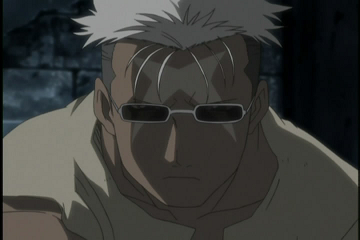 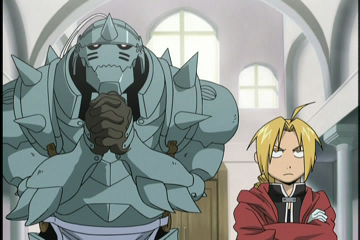 Whether you acknowledge it as good or not is irrelevant. Fullmetal Alchemist has already left its mark on anime and has impacted the industry like nothing else has since the 90s. It represents the utmost in advertising, media hyperbole, exposure and critical acclaim. It is, indubitably, the anime spectacle of our time. As such, Fullmetal Alchemist is a controversial topic. Like anything exceedingly popular, there are many who love it, many who hate it, and arguments between the two opposing forces are as visceral as they are frequent. So is it a good anime? What is the final word? Well… difficult to say, really. 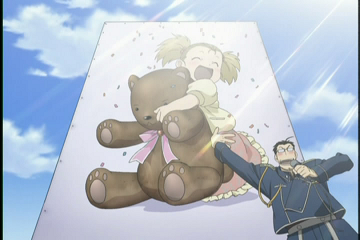 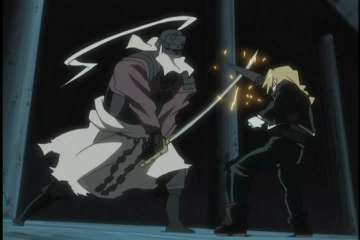 Fullmetal Alchemist Fullmetal Alchemist is the story of the Elric brothers; Edward and Alphonse they are named. Having lost their mother when they were kids, Ed and Al attempt to use a scientific skill called Transmutation to bring their mother back to life. This act of reviving the dead is a great taboo, and Ed and Al pay a hefty price. Ed loses an arm and a leg, and Al loses his entire body, spared complete destruction by having his soul imbued into a suit of armor. Years later, Ed and Al are State Alchemists traveling the world on missions, but also with a hidden agenda to find the Philosopher’s Stone. The Philosopher’s Stone is a magical item that allows Alchemy to be performed without the requirement of Equivalent Exchange, the process by which Ed and Al were malformed during the failed attempt at resurrection. They believe that with the Philosopher’s Stone, they can restore themselves and be normal again.   In spite of its fantastic setting and magical elements, Fullmetal Alchemist is foremost a story of two brothers and their dynamic relationship. Along the way, though, many other poignant angles are thrown at us, from racism to political corruption and even mass genocide. The characters involved in these angles are almost universally likable and well developed, from the other State Alchemists like Roy Mustang and Maes Hughes to the evil yet largely misunderstood Homonculi. When looked at as a whole piece, the story in Fullmetal Alchemist is great. 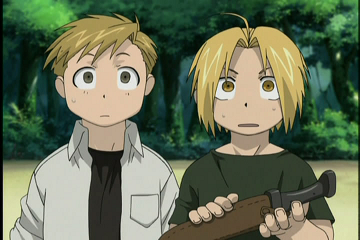 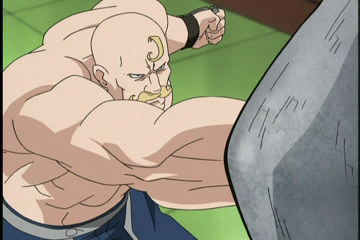 But when you sift through the finer details, the story slips up a bit. See, Fullmetal Alchemist has a hard time maintaining its dramatic focus, a flaw inherent in director Seiji Mizushima’s work (been watching Gundam 00?). The story bounces between serious and comic a bit too suddenly at times, and certain plot elements are built up wonderfully and then abandoned shortly after they reach their apex. For example, and I try to avoid spoilers as much as possible, but about halfway through the series, a certain key character is killed. Your emotions swirl about and you cannot wait to see what sort of impact that character’s death will have on the other characters around him and the overall flow of the story. Then, you find out, there really is no reaction. The episodes that follow are filler, for the most part, and when you finally do get a belated reference to that character’s passing, it almost feels frivolous at that point. It is quite frustrating for me, having invested so much into a certain plot element, only to see it more or less discarded. And this is not the only time this happens. 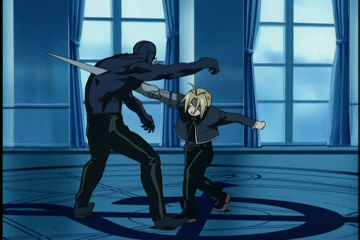 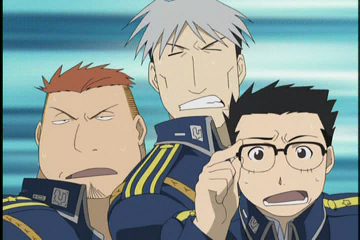 As a Bones production, Fullmetal Alchemist naturally looks great. While the animation is not absolutely mind blowing like, say, the previously released Last Exile[/i], it is extremely consistent. Almost every episode looks about as great as the last, even the ones that are not particularly important to the story. The character designs are wonderful as well, and fairly original, as I cannot quite compare the look of Fullmetal Alchemist’s characters to characters found in any other show. Particularly, they did an excellent job designing Al’s iconic armor and bringing it to life in a way that allows his static, metal face to be just as full of expression as any other character in any show. 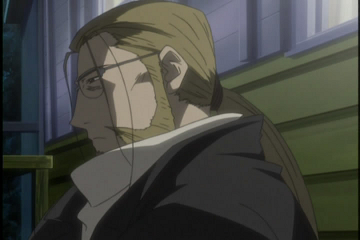  Fullmetal Alchemist Fullmetal Alchemist sounds as great as it looks, if not better. Michiru Oshima’s whimsical orchestral soundtrack never feels forced or overly performed. It strikes the perfect mood for nearly every scene. The vocal music selections for the openings and endings are also great, with some of J-rock’s finest getting you ready for every episode. The voice acting is also superb. As good as the Japanese audio is, I have to say, the dub totally blew me away and I can no longer imagine watching Fullmetal Alchemist any other way. Vic Mognagna completely steals the show as Ed. He provides a cynical and sarcastic edge that meshes beautifully with every nook and cranny of Ed’s character. Aaron Dismuke, though young, does an exceptional job as Alphonse and cements himself as quite possibly the best voice actor for child characters the world over. 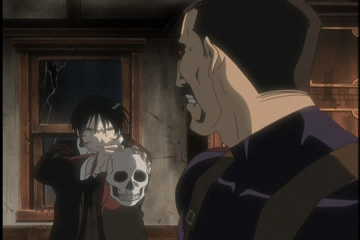 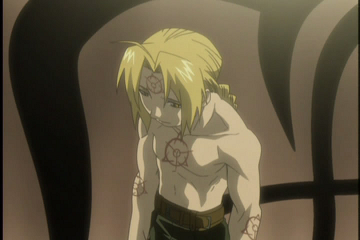 A few glaring plot hiccups aside, Fullmetal Alchemist is a great show. Ripe with feeling and emotion, there is no doubt that it will have some kind of impact on every person who watches it. It is both entertaining and poignant, and aside from a few filler arcs, makes very good use of its long, 51-episode run. While by no means the greatest anime ever made, it is a must see for all those who appreciate this form of entertainment. If you have not seen it yet, discard any preconceived notions you have about it and simply dive headlong into it. You will not regret it. - Shalashashka
Story: B
Animation: A
Design: S
Music: S
Direction: A
Overall: A-
Sub or Dub: Definitely dub
OP1 (2-13): “Melissa” by Porno GraffitiExtremely catchy rock song. The best song on the soundtrack. A+
ED1 (2-13): “Incredible Sin” by Nana KitadeFun, upbeat song. B
OP2 (14-25): “Ready-Steady-Go” by L’arc~en~cielOverrated, but catchy nonetheless. B+
ED2 (14-24): “The Other Side of the Door[/url]” by Yellow Generation[/b] Awesome vocal song with sweeping violin strings. A+
OP3 (26-41): “Undo” by Cool JokePretty good song, but the vocals sound a bit weird at times. B+
ED3 (26-41): “Motherland” by Crystal KaySurprisingly good R&B song. B+
OP4 (42-51): “Rewrite” by Asian Kung-fu GenerationVery nice rock intro. Probably the second best vocal song on the album. A
ED4 (42-50): “I Will” by SoweluAnother nice R&B ending. Better than the first. AInterested in this anime? Buy it here!
|
|